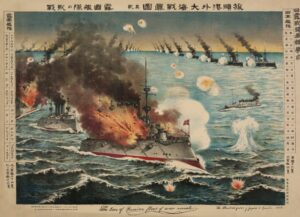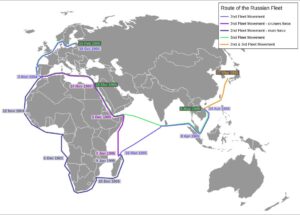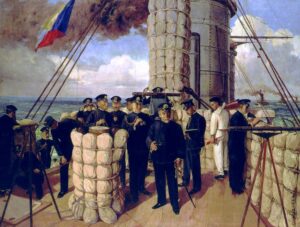manchuria
 It’s a difficult thing to discover that, as a nation, with a naval fleet, what you thought was strong, is simply not enough. This was the position that Russia found themselves during the Russo-Japanese War, when the Russian Baltic Fleet is nearly destroyed at the Battle of Tsushima Strait. The defeat was devastatingly decisive. Only 10 of the 45 Russian warships were able to escape to safety. The Russian leaders had to face the fact that further resistance against Japan’s imperial designs for East Asia was hopeless. They could not do it alone.
It’s a difficult thing to discover that, as a nation, with a naval fleet, what you thought was strong, is simply not enough. This was the position that Russia found themselves during the Russo-Japanese War, when the Russian Baltic Fleet is nearly destroyed at the Battle of Tsushima Strait. The defeat was devastatingly decisive. Only 10 of the 45 Russian warships were able to escape to safety. The Russian leaders had to face the fact that further resistance against Japan’s imperial designs for East Asia was hopeless. They could not do it alone.
The Japanese wanted to divide Manchuria and Korea into spheres of influence, but the plan was rejected by the Russians on February 8, 1904, following the Russian rejection of a Japanese plan to Japan launched a surprise naval attack against Port Arthur, a Russian naval base in China. With that attack, the war was on. The Battle of Port Arthur on February 8 and 9, 1904 marked the commencement of the Russo-Japanese War. The Japanese, in true Japanese style attacked when all the ships were still in port, but I guess that is how war is. It reminds me of Pearl Harbor, of course. The attack was a surprise night attack by a squadron of Japanese destroyers on the neutral Russian fleet anchored at Port Arthur, Manchuria. They continued with another attack the following morning. The fighting would continue until  May 1904. While the attack on Port Arthur ended inconclusively, the war was without a doubt, a Japanese victory. The Battle of Port Arthur was the first major battle of the 20th century, and the Russian fleet was decimated. During the war that began then, Japan won a series of decisive victories over the Russians, who underestimated the military potential of its non-Western opponent. In January 1905, the continued attacks resulted in the fall of Port Arthur to Japanese naval and ground forces under Admiral Heihachiro Togo, and by March Russian troops were defeated at Shenyang, China, by Japanese Field Marshal Iwao Oyama. Then came the Battle of Tsushima Strait, fought on May 27 and 28, 1905 (May 14 and 15 in the Julian calendar that Russia used at that time) in the Tsushima Strait located between Korea and southern Japan.
May 1904. While the attack on Port Arthur ended inconclusively, the war was without a doubt, a Japanese victory. The Battle of Port Arthur was the first major battle of the 20th century, and the Russian fleet was decimated. During the war that began then, Japan won a series of decisive victories over the Russians, who underestimated the military potential of its non-Western opponent. In January 1905, the continued attacks resulted in the fall of Port Arthur to Japanese naval and ground forces under Admiral Heihachiro Togo, and by March Russian troops were defeated at Shenyang, China, by Japanese Field Marshal Iwao Oyama. Then came the Battle of Tsushima Strait, fought on May 27 and 28, 1905 (May 14 and 15 in the Julian calendar that Russia used at that time) in the Tsushima Strait located between Korea and southern Japan.
While hope seemed lost, Russian Czar Nicholas II still hoped that the Russian Baltic fleet under Admiral Zinovy Rozhestvensky would be able to challenge Admiral Togo’s supremacy at sea. Unfortunately, during the two-day Battle of Tsushima Strait, more than 30 Russian ships were sunk or captured by the superior Japanese warships. Japanese superiority was made abundantly clear. By August, with a stunning string of Japanese victories, Russia became convinced that they would have to accept the peace treaty mediated by US President  Theodore Roosevelt at Portsmouth, New Hampshire…a treaty that won Roosevelt the Nobel Peace Prize for this achievement. In the Treaty of Portsmouth, Russia recognized Japan as the dominant power in Korea and gave up Port Arthur, the southern half of Sakhalin Island, and the Liaotung Peninsula to Japan.
Theodore Roosevelt at Portsmouth, New Hampshire…a treaty that won Roosevelt the Nobel Peace Prize for this achievement. In the Treaty of Portsmouth, Russia recognized Japan as the dominant power in Korea and gave up Port Arthur, the southern half of Sakhalin Island, and the Liaotung Peninsula to Japan.
Japan emerged from the conflict as the first modern non-Western world power and set its sights on greater imperial expansion. Japan would have to be dealt with another day, and by another power. As for Russia, the military’s disastrous performance in the war sparked the Russian Revolution of 1905.

